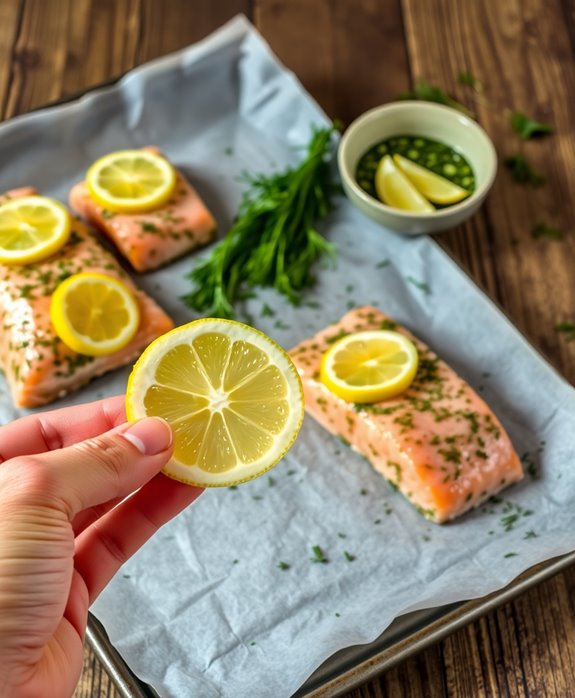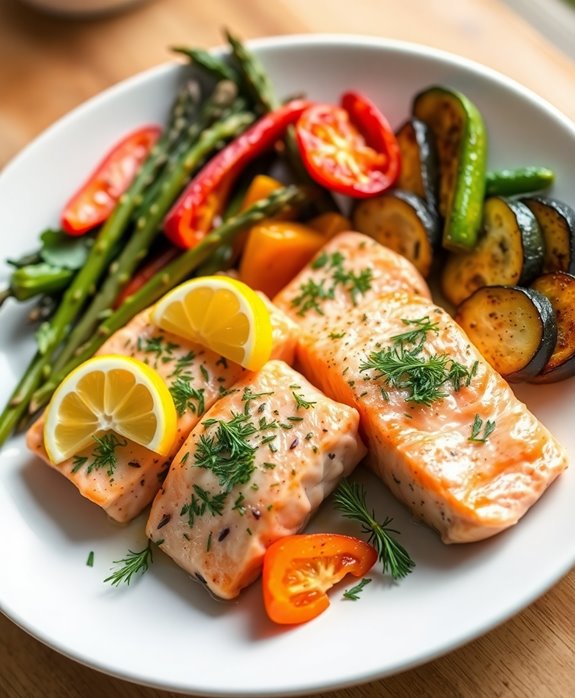When you’re looking to enjoy salmon without the excess salt, it’s crucial to focus on enhancing its natural flavors. You can achieve this by using fresh herbs, a splash of lemon juice, and a drizzle of olive oil, which not only brings out the fish’s richness but also contributes to a healthier dish. Baking is a straightforward method that keeps the salmon tender and flaky, perfect for a satisfying meal. Curious about how to put this all together and the benefits that come with it? Let’s explore the recipe and its advantages further.
Tips and Tricks
- Rinse and dry the salmon, checking for pin bones before seasoning it with herbs, olive oil, and lemon juice.
- Bake the seasoned salmon at 375°F to retain moisture and achieve a tender texture.
- Use fresh dill and lemon slices to enhance the flavor without adding excessive salt.
- Serve the salmon with sides like roasted vegetables or creamy mashed potatoes for a balanced meal.
- Enjoy the health benefits of salmon, rich in omega-3s and low in sodium, promoting overall wellness.
History
When you think about the history of salmon, it’s fascinating to realize that this fish has been a staple in human diets for thousands of years. Indigenous peoples of the Pacific Northwest revered salmon not just as a food source, but as an essential part of their cultural identity. They celebrated its return every year with festivals, recognizing the fish’s importance in their ecosystem and economy.
Beyond its cultural significance, salmon is packed with health benefits that have made it a favorite for generations. Rich in omega-3 fatty acids, it’s known to support heart health, improve brain function, and reduce inflammation. People have recognized these advantages throughout history, making salmon a sought-after ingredient in various cuisines around the world.
In many ancient cultures, salmon was seen as a gift from nature, often featured in rituals and daily meals. Its versatility allowed it to be smoked, dried, or cooked fresh, ensuring its place on the dinner table. Today, as you explore recipes and cooking methods, you’re not just preparing a meal; you’re engaging with a rich history that celebrates the enduring bond between humans and this remarkable fish. Additionally, the popularity of salmon has led to an increase in low-sodium salmon dishes that cater to modern health-conscious eaters.
Recipe

Cooking salmon can be a delightful experience, especially when you focus on enhancing its natural flavors without relying heavily on salt. This low salt salmon recipe isn’t only simple but also brings out the deliciousness of the fish while promoting a healthier lifestyle. With a few fresh ingredients, you can create a dish that’s satisfying and full of taste, perfect for a weeknight dinner or a special occasion.
In this recipe, you’ll learn how to prepare and cook salmon with a blend of herbs and spices that complement its rich flavor without the need for excessive salt. The method is straightforward and can be easily adapted to suit your taste preferences. Get ready to enjoy a delicious, low-sodium meal that everyone will love! Additionally, incorporating salmon into your diet can provide valuable omega-3 fatty acids, which are beneficial for heart health.
Ingredients:
- 4 salmon fillets
- 2 tablespoons olive oil
- 1 lemon (zested and juiced)
- 2 cloves garlic (minced)
- 1 teaspoon fresh dill (chopped)
- 1 teaspoon fresh parsley (chopped)
- 1/2 teaspoon black pepper
- 1/4 teaspoon paprika
- Lemon wedges (for serving)
To cook the salmon, start by preheating your oven to 400°F (200°C). In a small bowl, mix the olive oil, lemon zest, lemon juice, minced garlic, dill, parsley, black pepper, and paprika.
Place the salmon fillets on a baking sheet lined with parchment paper and brush the herb mixture generously over each fillet. Bake in the preheated oven for 12-15 minutes, or until the salmon is cooked through and flakes easily with a fork. Serve with lemon wedges for an extra burst of flavor.
For the best results, choose fresh, high-quality salmon fillets, as they’ll enhance the dish considerably. Feel free to experiment with other herbs and spices, such as thyme or rosemary, to customize the flavor to your liking.
Additionally, consider pairing this dish with a side of roasted vegetables or a fresh salad to create a well-rounded meal that’s both nutritious and delicious.
Cooking Steps
To get started on your low salt salmon, first, prepare your fresh fillets by patting them dry and placing them skin-side down.
Next, season your salmon with a mix of fragrant herbs to enhance its natural flavor. You can elevate the taste further by adding magic salmon seasoning, which brings out the best in the fish.
Once seasoned, pop it in the oven at 375°F for a deliciously tender finish.
Step 1. Prepare Salmon Fillets

With a sharp knife in hand, you’re ready to prepare your salmon fillets for a delicious, low-salt meal. First, choose your salmon varieties—whether it’s the rich, buttery taste of king salmon or the firmer texture of sockeye, each brings its unique flavor. Rinse the fillets under cold water to remove any residue, then pat them dry with a paper towel.
Next, inspect the fillets for any pin bones. Use your tweezers or the tip of your knife to gently pull them out. This step guarantees a smooth eating experience without any surprises.
Once your fillets are clean and bone-free, you can trim the edges if desired for a cleaner presentation.
Consider how you’ll cook your salmon. Different cooking techniques like grilling, baking, or pan-searing can bring out the natural flavors of the fish. Each method requires slightly different preparations, so keep that in mind.
For instance, if you’re grilling, you may want to leave the skin on for added moisture. Remember that Scottish salmon is known for its high quality and rich flavor profile, making it a great choice for your dish. With your fillets prepped, you’re one step closer to creating a mouthwatering, low-salt dish that showcases the best of your chosen salmon variety.
Step 2. Season With Herbs

Herb seasoning can elevate your salmon fillets to a new level of flavor while keeping things low in salt. By using fresh or dried herbs, you can enhance the taste of your dish without relying on sodium. Opt for herbs like dill, parsley, or thyme, which not only add vibrant flavors but also come with numerous herb benefits, such as anti-inflammatory properties and antioxidants.
To get started, finely chop your selected herbs and mix them with a bit of olive oil, lemon juice, and black pepper. This combination not only brings out the natural richness of the salmon but also acts as a marinade, allowing those flavors to penetrate the fish.
You can also experiment with seasoning techniques like rubbing the herb mixture directly onto the fillets for an even more intense flavor profile. Additionally, choosing salmon as your protein source is beneficial due to its high content of omega-3 fatty acids, which are known for their heart health advantages.
Don’t be afraid to get creative! Try adding garlic or shallots to your herb blend for an aromatic touch. The key is to focus on balancing the flavors, ensuring that the herbs complement the salmon rather than overpower it.
With these simple steps, you’re on your way to a delicious, low-salt dish that’s packed with flavor.
Step 3. Bake at 375°F

Preheating your oven to 375°F creates the perfect environment for baking salmon to tender perfection. This temperature is ideal for various salmon varieties, enabling them to cook evenly while retaining their natural moisture and flavor.
As you place your seasoned salmon fillets on a baking sheet lined with parchment paper or foil, make sure they’re spaced out to allow for even heat circulation.
Utilizing effective baking techniques is key here. For thicker cuts, a cooking time of 15-20 minutes should do the trick, while thinner pieces might only require 10-12 minutes. Keep an eye on the salmon, as overcooking can lead to dryness. The fish should flake easily with a fork when it’s done, indicating that it’s reached the perfect doneness.
You’ll love how the gentle heat enhances the herbs you’ve added, creating a delicious aroma that fills your kitchen. This method not only preserves the delicate flavors of the salmon but also makes it a healthy, low-salt option for your meals. Additionally, serving the salmon alongside creamy mashed potatoes can complement the dish beautifully.
Enjoy the simplicity and satisfaction of a beautifully baked salmon dish!
Step 4. Add Lemon Slices

Enhancing the flavor of your salmon, and adding fresh lemon slices is a simple yet impactful step in the cooking process. As you prepare your dish, grab a couple of ripe lemons. Slice them into thin rounds, guaranteeing you capture both the zest and the juicy goodness inside. The bright, tangy notes of the lemon beautifully complement the rich, savory flavor of the salmon, creating a delightful citrus pairing that elevates the entire meal.
When you place the lemon slices on top of the fish, not only do they infuse the salmon with a revitalizing taste, but they also bring along numerous lemon benefits. Rich in vitamin C and antioxidants, lemons can aid digestion and boost your immune system. The acidity of the lemon interacts harmoniously with the natural oils of the salmon, enhancing its flavor while also helping to tenderize the fish. Additionally, the combination of lemon and salmon is known to promote heart health, making this dish not only delicious but also beneficial for your well-being.
As your salmon bakes, the lemon slices will release their juices, creating a flavorful sauce that you can drizzle over the finished dish. This simple step guarantees your low salt salmon isn’t only healthy but also bursting with vibrant, zesty flavor. Enjoy the perfect balance!
Step 5. Garnish With Fresh Dill

A generous sprinkle of fresh dill can take your low salt salmon to the next level, adding a burst of flavor and a pop of color to your dish. Dill has numerous benefits, including its ability to enhance digestion and provide antioxidants, making it not just a pretty garnish but a nutritious one, too. Fresh dill is also known for its anti-inflammatory properties, which can further support your overall health.
When selecting your dill, you’ll find various dill varieties, such as ‘Bouquet’ and ‘Fernleaf.’ ‘Bouquet’ has a robust flavor and is great for cooking, while ‘Fernleaf’ boasts a milder taste and is perfect for fresh garnishes. Choose the type that complements your dish best.
To garnish, finely chop a handful of fresh dill and sprinkle it generously over your perfectly cooked salmon. The bright green hue against the pink flesh of the fish creates an appetizing visual contrast.
If you want to elevate the flavor even more, consider mixing some chopped dill with a squeeze of lemon juice before adding it to your salmon. This combination will enhance the freshness and make your meal truly memorable.
Enjoy your delicious low-salt salmon, knowing you’ve added a touch of elegance with this simple yet effective garnish!
Nutrition Facts
When you whip up this low-salt salmon recipe, you’re not just treating your taste buds; you’re also nourishing your body with essential nutrients. Salmon is packed with high-quality protein, which helps build and repair tissues while keeping you satiated.
It’s rich in omega-3 fatty acids, known for their heart-healthy benefits. These fats can lower blood pressure and reduce inflammation, promoting overall cardiovascular health.
By keeping the sodium intake low in this recipe, you’re making a smart choice for your heart. High sodium levels can lead to increased blood pressure and other health issues, so this dish is perfect for anyone looking to maintain a balanced diet.
Additionally, salmon provides a range of vitamins and minerals, including vitamin D and selenium, both of which play vital roles in bone health and immune function. Canned salmon is also a convenient source of these nutrients, making it easy to incorporate into your meals.
This low salt salmon recipe not only satisfies your cravings but also supports your long-term well-being. When you enjoy this dish, you embrace the numerous health benefits it offers, making it an excellent addition to your weekly meal rotation.
Final Thoughts
How can you resist the delicious allure of a low salt salmon dish that’s both flavorful and beneficial for your health? This recipe doesn’t just promise a culinary delight; it also opens the door to numerous health benefits.
Salmon is packed with omega-3 fatty acids, which are essential for heart health and brain function. By reducing the salt, you’re enhancing the natural flavor profiles of the fish while keeping it heart-healthy.
Imagine savoring each bite, where the tender, flaky texture of salmon meets the vibrant zing of herbs and citrus. The combination elevates the dish, making it a feast for your taste buds without overwhelming your body with sodium.
You’ll find that the burst of flavors not only satisfies your cravings but also contributes to your overall well-being. Plus, incorporating fresh herbs and citrus into your dish can further amplify the health benefits of salmon while providing a refreshing twist.
Frequently Asked Questions
Can I Use Fresh Salmon Instead of Frozen?
Yes, you can use fresh salmon instead of frozen. Fresh salmon typically offers a firmer texture and richer flavor, enhancing your dish. Just make certain it’s properly stored and cooked to retain its delicious qualities. Enjoy your meal!
How Do I Store Leftover Low Salt Salmon?
Storing leftover salmon can feel tricky, but it’s simple! You’ll want to wrap it tightly to maintain freshness. Explore creative salmon storage ideas, like salads or sandwiches, to enjoy those delicious leftovers in new ways!
Is This Recipe Suitable for Meal Prep?
Yes, this recipe’s perfect for meal prep! It offers great meal prep benefits, allowing you to practice portion control. You’ll enjoy delicious, healthy meals throughout the week without compromising taste or nutrition.
Can I Add Herbs to the Salmon?
You can add herbs to the salmon! Herb combinations like dill and parsley or thyme and rosemary provide a delightful flavor enhancement, transforming your dish into a culinary masterpiece that tantalizes your taste buds. Enjoy experimenting!
What Side Dishes Pair Well With Low Salt Salmon?
When you’re choosing side dishes, consider roasted vegetables, quinoa salad, or steamed asparagus. These options not only complement salmon but also enhance flavors, showcasing diverse cooking techniques and adding depth to your meal experience.







